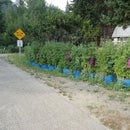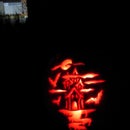Introduction: Solar Heater With Reclaimed Materials
In This instructable, we are going to make a solar heater, with reclaimed fence wood, a recycled pane of glass, some empty rockstar cans, some recycled cardboard, and a few screws,
Step 1: Materials / Tools
For this project, you will need:
A piece of glass, (The size of which will determine the overall size of the finished heater)
Some screws (length will vary, depending apon the wood used, most of my wood was about a half inch thick, so I used 1" screws)
Some cans (can be food cans, soda, beer, ect)
Flat black spray paint (.96 cents at Wal mart, number of cans of paint, I suggest getting at least 3 or 4)
a screwdriver (I used an electric drill)
reclaimed wood (I used some fence panels)
A few pieces of cardboard to line the inside of the heater for insulation)
A 1" hole saw
a 1/2" drill to drill holes in the bottoms of the cans
Step 2: Building the Box
I laid out the boards I planned to use for the back, making sure that they overlapped the piece of glass I had sourced from a local K mart store that was closing down, once measured, I removed the glass and set it aside in a safe place to start the build.
To connect the 9 white fence planks together, I measured the width, which was 32" and cut three pallet boards to that length, and screwed them onto the back of what would become our box.
After the back is secured, I flipped it over, and pulled some nails out of the 2x4's that held the fence planks together originally (When it was still fencing). One was a perfect length already, the other was a few inches too long to fit on the frame, so I used a skil saw to even them out.
The 2x4's will make up the sides of your box which the pane of glass will actually sit on. I set them on the flat piece we have built already, and then set the glass on top of them to make sure that they were lined up with the edges of the glass, and then used some screws (one on each end) to secure the 2x4's to the frame. (after thy are secured, it will need to be flipped over, so that some screws can be driven into the 2x4's from the back side.)
Once the 2x4's are secured, and in position, I used a piece of pallet wood, slightly taller than the 2x4 on each side (outside to the 2x4) to hold the glass and keep it from sliding off either side. The bottom of the box can then be attatched as well as can the top.
Once the box is complete, it is time for cardboard. I laid in a few large pieces I had laying around, and used a staple gun to attatch the cardboard to the inside of the box.
Once the cardboard is in it is time for cans!
Step 3: The Cans and Placing Glass
Using a 1/2" drill, drill a hole in the center of each can, this heater fit a total of 80 cans. once you have at leas the bottom row in, you can use the hole saw to drill holes in the bottom of the box, one directly under each row of cans, this one was 10 cans wide, so I drilled 10 holes on the bottom. On the top side, you want to restrict air flow slightly so that it has time to heat up, so I sued the same 1" hole saw, and only drilled 4 holes spaced across the top side of the heater.
Once the holes are sawed, get your cans all into place, and then it is time to PAINT! YAY!
I only sprayed one side of the cans, since they were goint to be sandwiched beweeen the cardboard, and the glass pretty firmly and would not be able to turn and move once the glass was installed. Remember, FLAT black spray paint, and make sure to cover them with a couple coats, so they are BLACK.
Once the drilled cans are installed, it's time to set the glass onto the box!
Once the glass is installed, it is time to add braced on top and bottom of the heater, for this, I went back to the pallet wood, I cut two peices, 32" long (the width of my box), and once is fixed OVER the glass on top, and bottom, holds the glass in place, and keeps it from moving.
Step 4: DONE! Get It in the SUN!!
Once your all done, get it into the sun and test it out!
Within about 10 minutes of setting it in the sun, I realized that my digital thermometer tops out at 158 degrees, so I grabbed my candy thermometer, which may not be as accurate at measureing air temp, but it ended up getting up to about 180 degrees, great success!!






